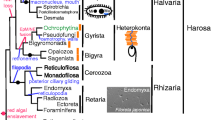Abstract
Inhibition of hydrogen transfer between NADH and Co Q by rotenone or amytal in salivary gland cells of Drosophila hydei maintained in vitro, results in the activation of a particular group of four loci in the polytene chromosomes (puff formation). The response of these loci to the same treatment is enhanced if Na-malonate is present in the incubation medium. — Three of the loci become active if the glands are kept in a medium supplied with antimycin A or 2-heptyl-4-hydroxyquinoline-N-oxide (H QNO), specific inhibitors of the electron transfer between cytochromes b and c. — It was established that a temperature treatment and DNP raise oxygen consumption of the cells to a certain level. Following the same treatments of glands supplied with Na-malate and Na-succinate the raise in oxygen consumption attains a significantly higher level. Under these conditions no response is observed at the genome level. — Whereas DNP, which uncouples oxidative phosphorylation and enhances the respiratory chain reactions, does induce the initiation of puff formation, oligomycin, which inhibits oxidative phosphorylation and suppresses the respiratory chain reactions, is ineffective in initiating puff formation at the specific loci. However, if oligomycin is supplied to the medium in combination with KCN which inhibits the cytochrome oxidase activity, three of the four loci become active. — The presence in the medium of substances which may act as hydrogen acceptors, e.g. menadione or methylene blue, can also result in activation of the chromosome loci. — These results are interpreted as indications for the existence of a regulatory mechanism between mitochondrial respiratory metabolism and the activity of a particular group of genome loci.
Similar content being viewed by others
References
Ashburner, M.: Pattern of puffing activity in the salivary gland chromosomes of Drosophila. V. Response to environmental treatments. Chromosoma (Berl.) 31, 356–376 (1970).
Berendes, H. D.: The hormone ecdysone as effector of specific changes in the pattern of gene activities of Drosophila hydei. Chromosoma (Berl.) 22, 274–293 (1967).
Berendes, H. D.: Factors involved in the expression of gene activity in polytene chromosomes. Chromosoma (Berl.) 24, 418–437 (1968).
Berendes, H. D., Breugel, F. M. A. van, Holt, Th. K. H.: Experimental puffs in salivary gland chromosomes of Drosophila hydei. Chromosoma (Berl.) 16, 35–47 (1965).
Boyd, J. B., Berendes, H. D., Boyd, H.: Mass preparation of nuclei from the larval salivary glands of Drosophila hydei. J. Cell Biol. 38, 369–376 (1968).
Breugel, F. M. A. van: Puff induction in larval salivary gland chromosomes of Drosophila hydei Sturtevant. Genetica ('s-Gravenhage) 37, 17–28 (1966).
Ernster, L., Lee, C. P.: Biological oxidoreductions. Ann. Rev. Biochem. 33, 729–788 (1964).
Helmsing, P. J., Berendes, H. D.: Induced accumulation of nonhistone proteins in polytene nuclei of Drosophila hydei. J. Cell Biol. 50, 893–896 (1971).
Konings, A. W. T.: Substrate supply for nuclear oxidative phosphorylation. Biochim. biophys. Acta (Amst.) 223, 398–408 (1970).
Konings, A. W. T.: The influence of iodoacetate on the mechanism of nuclear glucose oxidation. Experientia (Basel) 27, 253–254 (1971).
Kroon, A. M.: DNA and RNA from mitochondria and chloroplasts (biochemistry). In: Handbook of molecular cytology (A. Lima-de-Faria, ed.). Amsterdam-London: North Holland Publ. Cy. 1969.
Kroon, A. M., Vries, H. de: Mitochondriogenesis in animal cells: studies with different inhibitors. In: Autonomy and biogenesis of mitochondria and chloroplasts (N. K. Boardman, A. W. Linnane, and R. M. Smillie, eds.). Amsterdam-London: North Holland Publ. Cy. 1971.
Leenders, H. J., Wullems, G. J., Berendes, H. D.: Competitive interaction of adenosine 3′, 5′-monophosphate on gene activation by ecdysterone. Exp. Cell Res. 63, 159–164 (1970).
Mahler, H. R., Cordes, E. H.: Biological chemistry. New York-Evanston-London: Harper and Row 1969.
Quastel, J. H.: Use of artificial electron acceptors in the study of dehydrogenases. In: Methods in enzymology (S. P. Colowick and N. O. Kaplan, eds.). New York: Academic Press Inc. 1957.
Ritossa, F.: A new puffing pattern induced by temperature shock and DNP in Drosophila. Experientia (Basel) 18, 571–572 (1962).
Ritossa, F.: New puffs induced by temperature shock, DNP and salicylate in salivary chromosomes of D. melanogaster. Dros. Inf. Serv. 37, 122 (1963).
Ritossa, F.: Experimental activation of specific loci in polytene chromosomes of Drosophila. Exp. Cell Res. 35, 601–607 (1964).
Slater, E. G.: Manometric methods and phosphate determination. In: Methods in enzymology (R. W. Estabrook and M. E. Pullman, eds.), vol. 10. New York-London: Acad. Press Inc. 1967a.
Slater, E. G.: Application of inhibitors and uncouplers for a study of oxidative phosphorylation. In: Methods in enzymology (R. W. Estabrook and M. E. Pullman, eds.), vol. 10. New York-London: Acad. Press Inc. 1967b.
Author information
Authors and Affiliations
Rights and permissions
About this article
Cite this article
Leenders, H.J., Berendes, H.D. The effect of changes in the respiratory metabolism upon genome activity in Drosophila . Chromosoma 37, 433–444 (1972). https://doi.org/10.1007/BF00284892
Received:
Accepted:
Issue Date:
DOI: https://doi.org/10.1007/BF00284892




